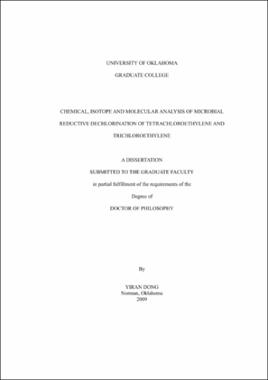| dc.contributor.advisor | Butler, Elizabeth C||Krumholz, Lee R | |
| dc.creator | Dong, Yiran | |
| dc.date.accessioned | 2019-04-27T21:32:12Z | |
| dc.date.available | 2019-04-27T21:32:12Z | |
| dc.date.issued | 2009 | |
| dc.identifier | 99275989802042 | |
| dc.identifier.uri | https://hdl.handle.net/11244/318940 | |
| dc.description.abstract | Tetrachloroethylene (PCE) and trichloroethylene (TCE) are among the most commonly detected groundwater contaminants in the U. S. Microbial reductive dechlorination of this group of contaminants was investigated in different reaction systems, including isolated pure cultures, enrichment cultures and microcosms. Chemical, isotope and molecular analyses were performed to evaluate the feasibility of stable carbon isotope fractionation to quantitatively monitor microbial PCE and TCE reductive dechlorination and the potential factors that may lead to uncertainties of this monitoring technique. | |
| dc.description.abstract | Microbial PCE and TCE reductive dechlorination was first analyzed and the product distribution and stable carbon isotope fractionation were determined in two isolated pure cultures (Sulfurospirillum multivoransand Desulfuromonas michiganensis Strain BB1) and one mixed culture, Bio-Dechlor Inoculum (BDITM). S. multivorans and D. michiganensis Strain BB1 produced cis-DCE when PCE or TCE was used as the parent substrate, while the Dehalococcoides-containing BDI was able to completely dechlorinate PCE and TCE to ethylene. Different extents of isotope fractionation were observed among the three cultures. Generally, weaker isotope fractionation occurred during PCE reductive dechlorination (enrichment factors (epsilon bulk) = -1.33 to -7.12 per mil) than that during TCE transformation (epsilon bulk = -4.07 to -15.02 per mil). The different levels of fractionation by individual species/culture might be due to their diversity in the structure of functional enzymes (e.g., reductive dehalogenase), cofactors or rate-limiting steps before enzymatic reactions. | |
| dc.description.abstract | In order to evaluate potential impacts of environmental factors (e.g., electron donors and pH) and microbial diversity on isotope fractionation during microbial reductive dechlorination of chlorinated ethylenes, two enrichment cultures (DPF and DPH) stimulated from the same source but in the presence of different electron donors were investigated. These two cultures showed significantly different product distribution and isotope fractionation. Chemical and isotope analyses indicate that electron donors and pH do not directly change the product distribution and only slightly changed extents of isotope fractionation. However, phylogenetic analysis of the 16S rRNA clone libraries of DPF and DPH suggests that electron donors might indirectly influence extents of isotope fractionation by leading to a shift in microbial community composition. | |
| dc.description.abstract | At contaminated sites, microbial and abiotic reductive dechlorination may simultaneously occur. To understand the relative contributions of these remediation processes and to evaluate the feasibility of applying isotope fractionation to monitor potentially parallel microbial and abiotic transformation processes, PCE and TCE reductive dechlorination was carried out in a series of well-defined microcosms. Alternative electron accepting processes, e.g., iron-, sulfate-reduction and methanogenesis, were developed to vary contents of biogenic iron and sulfide minerals; electron donors were spiked to stimulate indigenous dechlorinating bacteria. Our results showed that microbial reductive dechlorination was dominant in 21 out of 24 PCE microcosms and 5 out of 8 TCE microcosms. Isotope analysis indicated that weak isotope fractionation occurred in most microcosms, while some of them had very negative epsilon bulk. All of them were within the range of or comparable with the epsilon bulk of microbial reductive dechlorination of PCE and TCE that have been published so far. In addition, compared to the isotope fractionation during PCE and TCE abiotic reductive dechlorination by FeS, the extents of isotope fractionation observed in these microcosms was generally weaker. Higher environmental pH was suggested to be unfavorable for growth of dechlorinating bacteria. Meanwhile, the comparable levels of microbial and abiotic dechlorinated products were only observed in the microcosms with slow microbial reductive dechlorination, suggesting that abiotic dechlorination might be important only when microbial reductive dechlorination is slow. Comparison of geochemical conditions with abiotic product recoveries suggests that high concentrations of Fe(II) and S(-II) solid species produced under sulfate- and iron-reducing conditions are likely important for abiotic reductive dechlorination to occur. | |
| dc.description.abstract | In general, the different levels of isotope fractionation during microbial PCE and TCE reductive dechlorination observed in our pure culture, enrichment cultures and microcosm experiments, indicate to us that a number of factors need to be considered in applying isotope fractionation to quantitatively monitor bioremediation of this group of contaminants in the field. This includes whether the appropriate conditions have been selected for development of model enrichment cultures, potential indirect impacts of environmental factors (e.g., pH and electron donors) and impacts of different transformation pathways (e.g., abiotic versus microbial) on the extents of isotope fractionation. | |
| dc.format.extent | 165 pages | |
| dc.format.medium | application.pdf | |
| dc.language | en_US | |
| dc.relation.requires | Adobe Acrobat Reader | |
| dc.subject | Tetrachloroethylene--Environmental aspects | |
| dc.subject | Trichloroethylene--Environmental aspects | |
| dc.subject | Groundwater--Pollution | |
| dc.subject | Hazardous wastes--Natural attenuation | |
| dc.title | CHEMICAL, ISOTOPE AND MOLECULAR ANALYSIS OF MICROBIAL REDUCTIVE DECHLORINATION OF TETRACHLOROETHYLENE AND TRICHLOROETHYLENE | |
| dc.type | text | |
| dc.type | document | |
| dc.thesis.degree | Ph.D. | |
| ou.group | College of Engineering::School of Civil Engineering and Environmental Science | |
